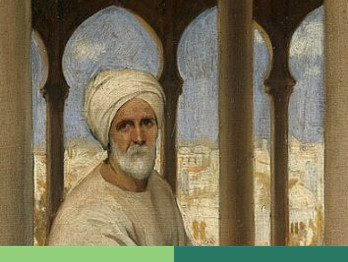- Science News
- Young Minds
- Al-Zahrawi – The father of modern surgery
Al-Zahrawi – The father of modern surgery

Frontiers for Young Minds takes you on a dive down into the depths of the historical scientific archives and introduces you to scientists you may have not heard about, but you should! This time, we tell you the story of Abu al-Qasim Khalaf bin Abbas Al-Zahrawi, known as Al-Zahrawi.
By Noor Fellah
A Star Is Born
Al-Zahrawi (known as Albucasis in Latin) was born near Cordoba, Andalusia (nowadays Spain) in 936 AD. He was fortunate in that he lived during the heydays of Islamic culture and civilization in Andalusia – where arts, science, commerce, and medical sciences flourished. He was a contemporary of Andalusian chemists such as Ibn al-Wafid, al-Majriti and Artephius. From early age, he showed interest in the medical sciences, and his desire to learn took him to study in Cordoba, the illuminating heart of European intellect at that time. He excelled his peers as a student, and became known as a revolutionary physician (doctor). In recognition of his skills, he was appointed as the court physician to the Caliph Al-Hakam II – giving him access to the most advanced medical knowledge of the time.
In his early days as a physician, Al-Zahrawi noticed his contemporaries’ primitive approach to surgical sciences, and decided to devote his entire life to expanding knowledge of anatomy. This still plays a pivotal role in today’s surgical approaches.
He famously advocated that surgery "should not be attempted except by one who has a good knowledge of the anatomy of the limbs and of the exits of the nerves that move the body”. Due to the limited expertise on cautery (surgical removal of human tissue) held by other physicians at that time, he also argued that procedures should not be attempted by anyone lacking "long training and practice in the use of cautery". Above all, his mission was to emphasise that a physician must not practice surgery until they became well-acquainted with all other branches of medicine – a perfectly normal expectation now, where doctors receive broad training in general medicine before specialising as surgeons, but a revolutionary assertion for his time.
A Pioneer
Al-Zahrawi pioneered neurosurgery and neurological diagnosis, and was the first physician to identify the hereditary nature of haemophilia (a condition that affects the blood's ability to clot), as well as the first to describe an abdominal pregnancy. Before his work, it was not known what exactly could cause paralysis, Al-Zahrawi was the first to explain how fracturing the spine can be responsible.
He pioneered ground-breaking medical procedures that were ascribed to later physicians, without any credit to Al-Zahrawi. Did you know that all these came from him?
what would later become known as "Kocher's method" for treating a dislocated shoulder
the "Walcher position", used for difficult childbirth deliveries.
how to ligature (connect) blood vessels - described almost 600 years before Ambroise Paré
the first migraine surgery - which Paré would also record 600 years later
surgical devices for Caesarean sections and cataract surgeries
A Social Justice Advocate
Al-Zahrawi insisted on treating all patients regardless of their financial or social status. This allowed Al-Zahrawi to see a wide variety of people each day and record his treatment of them. He also believed in the importance of a positive doctor-patient relationship and wrote affectionately of his students, whom he referred to as "my children".
His skills in keeping precise, valid, medical records and detailed information about medical procedures was way ahead of his time. By doing so, the court physician left behind a valuable medical treatise known as Kitab Al Tafsir, the very first medical illustrated encyclopaedia in history.

Public Domain | Two pages from the Arabic manuscript of the Kitab al-Tasrif. Middle East, 13th century, Chester Beatty Library.
A Lasting Legacy
Kitab Al-Tafsir, Al-Zahrawi’s thirty-volume medical encyclopaedia, was finished in the year 1000. The encyclopaedia’s first volume deals with general medical principles, the second with pathology, and the majority of the remaining volumes cover pharmacology and drug-related topics.
The 30th volume entitled On Surgery and Instruments, was without a doubt his most significant achievement - its contents contributed to many technological innovations in medicine, notably which tools to use in specific surgeries. In his book, Al-Zahrawi illustrated pictures of each tool used in different operations to describe how to carry out each therapy process. More than 200 surgical tools were invented by Al-Zahrawi – a staggering achievement - and illustrated in the book, including a variety of scalpels, retractors, curettes, pincers, and specula as well as tools for his preferred cauterization and ligature techniques, and hooks with a double tip for use in surgery.
His use of catgut for internal stitching is still practised in modern surgery - it appears to be the only natural substance capable of dissolving and is tolerated by our bodies. This discovery was made by Al-Zahrawi after his monkey ate the strings of his oud (an instrument like a lute). He also invented the forceps for extracting a dead fetus.
Kitab Al-Tafsir was the book that gave Al-Zahrawi lasting authority in Europe as it was the first illustrated surgical guide ever written, and it remained the primary source on surgery in Europe for the next 500 years.
Remembering the Father of Modern Surgery
Al-Zahrawi was man ahead of his time, but today he is not given enough credit for his discoveries. He offered his services as a practitioner for more than five decades, and after a long and distinguished medical career, he died in 1013 AD at the age of 77, leaving behind a wealth of knowledge that people still benefit from to this very day.
Want to know more about forgotten scientists, have a look at our latest blog articles here from Frontiers for Young Minds.







